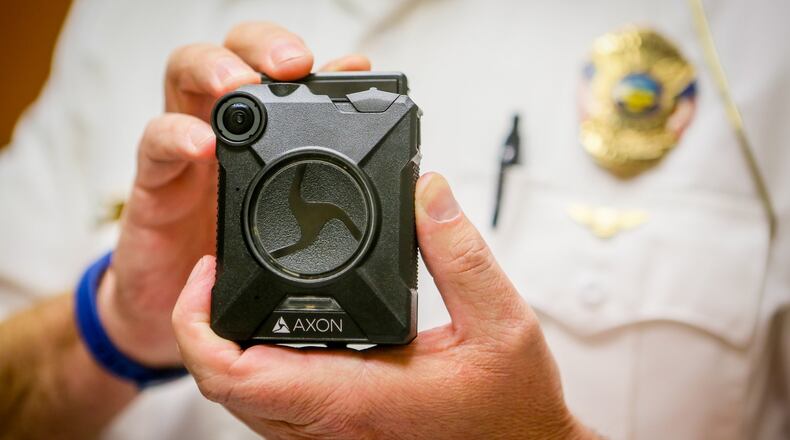Body cameras can protect local governments from frivolous lawsuits, said Mike “Spike” Jones, who now is the police chief of the Kenton County Police Department.
Citizens across the nation also have used body-camera videos to show abuse by officers.
Hamilton already has cruiser cameras, said Police Chief Craig Bucheit, but since the start of this year has explored body cameras.
“I’d say we’ve moved into Phase 2 at this point, which is actually testing and evaluating cameras,” Bucheit said.
Body cameras will move ahead if Hamilton council approves part of the proposed city budget: an allocation of $125,000 to buy both tasers, which use an electric current to incapacitate suspects, and body cameras.
Phase 3, actual deployment of the cameras, should happen in late 2017, Bucheit said.
When Jones was the chief of police in Covington, Ky., he recounted an incident where a man wanted to file a complaint against a Covington officer.
Jones said Covington police sat the man down to listen to his account of the incident, and then offered to show him video from the body camera worn by the officer involved in the incident. Upon learning the officer was wearing a camera, the disgruntled citizen no longer was interested in pursuing his complaint, Jones said.
Testing in Hamilton should last through the first or perhaps second quarter of 2017, Bucheit said.
“Building out one of these programs, in a department of our size is quite an undertaking,” Bucheit said. “We just want to make sure we take a deliberate, measured approach, and make sure we get it right, and develop a first-class program, which I think we’ve been on pace to do.”
“We’ve been swamped by companies trying to peddle their products,” said Bucheit, who declined to say which two companies’ cameras now are being tested. He noted other firms’ products also may be tested before a decision is made on which vendor to use.
“We want to fully vet the vendors, make sure the cameras, the hardware itself is user-friendly and compatible with our officers’ daily routines, that the storage and the capabilities are sufficient and meet our standards,” Bucheit said. “Lastly, it’s the software and storage, all the back-end details of these cameras.”
Middletown does not expect to begin using cameras soon.
“It is highly doubtful we will begin using body worn cameras in 2017. There are serious issues that have yet to be addressed with this equipment, most notably privacy issues,” Adkins wrote via email. “This equipment is different from dashboard cameras, in that footage of inside homes and businesses is captured. The Fourth Amendment guarantees people will be secure in their homes from unreasonable searches. Body-worn cameras nibble away at this protection.
“Further,” Adkins added, “cameras have been shown to impede police/citizen interactions, as individuals are more hesitant to speak openly when being recorded. Add to this the incredible cost of storage and other issues, and it becomes evident that body worn cameras are not the panacea that everyone believed at first. This is not to say that Middletown officers will never utilize this equipment, but rather that the time is not right.”
While Middletown is holding off on its deployment of such cameras, Bucheit notes that by the time Hamilton has all front-line officers wearing body cameras, some of those legal issues may already have been settled.
“The case law’s evolving, the hardware, the software’s evolving, and so we’re just continuing to monitor this very closely … in a rapidly evolving environment,” Bucheit said.
Bucheit agreed with Adkins that the case law is churning in unpredictable ways: “It’s an evolving technology, and every day there seems to be different twists and turns with the actual hardware or the software case law, so as it continues to evolve, we’re continuing to evaluate it,” Bucheit said.
Hamilton’s in-cruiser camera system, the chief noted, “and I think that has proven tremendously valuable in terms of just documenting incidents, providing compelling evidence in court, and also a very valuable tool for us as a department to evaluate our officers’ training, tactics, and then to assess any issues that have come up, whether it be complaints or compliments,” such as a woman who was grateful for an officer who helped her change a tire.
“It’s also a tool for us to ensure that if there are complaints or questions about an officer’s conduct, that we’re able to go back and evaluate those,” Bucheit said. “I just see this as an extension of the program that we’ve been working on, and building out, and continue to build out.”
As for cruiser cams and body cameras, “I look at these two as complementing each other,” Bucheit said.
About the Author
